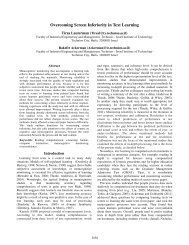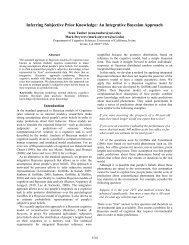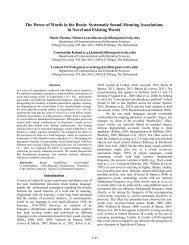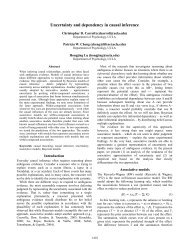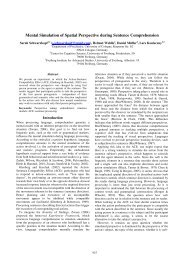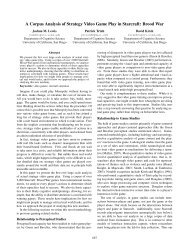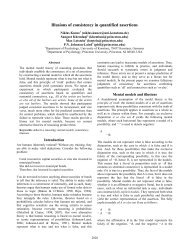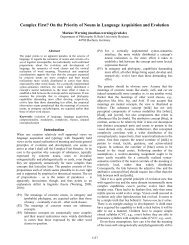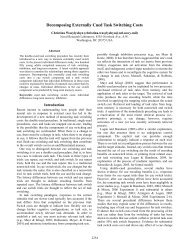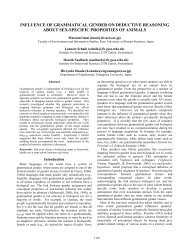Implicit theories of the causes of weight gain in adults
Implicit theories of the causes of weight gain in adults
Implicit theories of the causes of weight gain in adults
You also want an ePaper? Increase the reach of your titles
YUMPU automatically turns print PDFs into web optimized ePapers that Google loves.
<strong>Implicit</strong> <strong><strong>the</strong>ories</strong> <strong>of</strong> <strong>the</strong> <strong>causes</strong> <strong>of</strong> <strong>weight</strong> <strong>ga<strong>in</strong></strong> <strong>in</strong> <strong>adults</strong><br />
Nicole Ware<br />
School <strong>of</strong> Psychology, Charles Sturt University, Bathurst, NSW 2795, AUSTRALIA<br />
Dr Rachel Dryer (rdryer@csu.edu.au)<br />
School <strong>of</strong> Psychology, Charles Sturt University, Bathurst, NSW 2795, AUSTRALIA<br />
Abstract<br />
This study sought to explore <strong>the</strong> range <strong>of</strong> beliefs about <strong>weight</strong><br />
<strong>ga<strong>in</strong></strong> and whe<strong>the</strong>r <strong>the</strong>se beliefs varied accord<strong>in</strong>g to personal <strong>weight</strong><br />
management history. A questionnaire specifically designed for <strong>the</strong><br />
study was completed by 376 participants (94 males, 282 females;<br />
mean age 43.65 years, SD=13.24). Pr<strong>in</strong>cipal component analysis<br />
identified five causal attribution factors which were <strong>in</strong>terpreted as<br />
Lack-<strong>of</strong>-Self-Control, Lifestyle-Limitations, Psychological,<br />
Biological/Medical, and Modern-Liv<strong>in</strong>g. The level <strong>of</strong> endorsement<br />
for <strong>the</strong>se causal attribution factors suggested an acknowledgement<br />
<strong>of</strong> <strong>the</strong> multiple <strong>causes</strong> to <strong>weight</strong> <strong>ga<strong>in</strong></strong>. However, <strong>the</strong> most highly<br />
endorsed factor, Lack-<strong>of</strong>-Self Control, reflected <strong>the</strong><br />
“commonsense” view <strong>of</strong> <strong>weight</strong> <strong>ga<strong>in</strong></strong> be<strong>in</strong>g a matter <strong>of</strong> overeat<strong>in</strong>g,<br />
under-exercis<strong>in</strong>g and lack<strong>in</strong>g <strong>in</strong> self control. Personal <strong>weight</strong><br />
management history was found to be associated with variations <strong>in</strong><br />
beliefs with <strong>the</strong> more effort one had applied to <strong>weight</strong><br />
management; <strong>the</strong> more highly <strong>the</strong>y endorsed <strong>causes</strong> both with<strong>in</strong><br />
and outside <strong>of</strong> <strong>in</strong>dividual control.<br />
Keywords: implicit <strong><strong>the</strong>ories</strong>, causal explanations, <strong>weight</strong><br />
<strong>ga<strong>in</strong></strong>, obesity.<br />
Introduction<br />
Obesity is considered a worldwide epidemic (World<br />
Health Organization [WHO], 2000) with over half <strong>the</strong> adult<br />
population <strong>in</strong> many countries classified as ei<strong>the</strong>r over<strong>weight</strong><br />
or obese (Bovbjerg, 2008; Lim, Norman, Clifton, & Noakes,<br />
2008; Thorburn, 2005). Over<strong>weight</strong> and obesity are widely<br />
recognized as be<strong>in</strong>g associated with enormous<br />
psychological, health, and economic costs, both on<br />
<strong>in</strong>dividual and national scales (Stroebe, 2008). More<br />
recently it has been recognized that such costs occur with<br />
any level <strong>of</strong> <strong>weight</strong> <strong>ga<strong>in</strong></strong>. Increases <strong>in</strong> body <strong>weight</strong> <strong>of</strong> less<br />
than five kilograms have been found to be associated with<br />
<strong>in</strong>creased disease load, with <strong>the</strong> associations occurr<strong>in</strong>g even<br />
with<strong>in</strong> <strong>the</strong> healthy BMI range (Lim, et al., 2008; WHO,<br />
2000). This has contributed to <strong>the</strong> WHO‟s (2000) decision<br />
to advocate <strong>the</strong> prevention <strong>of</strong> <strong>weight</strong> <strong>ga<strong>in</strong></strong> <strong>in</strong> <strong>adults</strong> as <strong>the</strong><br />
key strategy <strong>in</strong> manag<strong>in</strong>g obesity. This strategy aims to<br />
prevent <strong>in</strong>itial <strong>weight</strong> <strong>ga<strong>in</strong></strong> <strong>in</strong> normal <strong>weight</strong> <strong>adults</strong>, as well<br />
as prevent<strong>in</strong>g fur<strong>the</strong>r <strong>weight</strong> <strong>ga<strong>in</strong></strong> <strong>in</strong> those who are already<br />
over<strong>weight</strong> or obese. At an <strong>in</strong>dividual level, prevention <strong>of</strong><br />
<strong>weight</strong> <strong>ga<strong>in</strong></strong> is quantified as <strong>ga<strong>in</strong></strong> <strong>of</strong> less than five kilograms<br />
across adulthood (B. A. Sw<strong>in</strong>burn, et al., 2004).<br />
Prevention <strong>of</strong> <strong>weight</strong> <strong>ga<strong>in</strong></strong> has now become a focus <strong>of</strong><br />
public discussion and debate, with numerous <strong><strong>the</strong>ories</strong> <strong>of</strong><br />
<strong>causes</strong> and solutions <strong>in</strong> <strong>the</strong> public arena (Faith, Fonta<strong>in</strong>e,<br />
Bask<strong>in</strong>, & Allison, 2007). Individual changes are <strong>of</strong>ten<br />
asserted as solutions (Lombard, et al., 2009) along with a<br />
range <strong>of</strong> population scale strategies which <strong>in</strong>clude education<br />
2511<br />
campaigns to raise community awareness about <strong>the</strong><br />
importance <strong>of</strong> healthy eat<strong>in</strong>g, healthy <strong>weight</strong> and physical<br />
activity; changes to urban design and land use to encourage<br />
physical activity; and reshap<strong>in</strong>g <strong>the</strong> food supply to <strong>in</strong>crease<br />
access to healthy food, restrict access to unhealthy foods<br />
and a regulation <strong>of</strong> <strong>the</strong> sugar, fat, and salt contents <strong>of</strong> foods<br />
(NOTF Obesity Work<strong>in</strong>g Group, 2009).<br />
Understand<strong>in</strong>g <strong>the</strong> beliefs and attitudes regard<strong>in</strong>g <strong>weight</strong><br />
<strong>ga<strong>in</strong></strong> held with<strong>in</strong> <strong>the</strong> community is extremely important for<br />
<strong>the</strong> acceptance and successful implementation <strong>of</strong><br />
population-level <strong>in</strong>terventions aimed at reduc<strong>in</strong>g <strong>weight</strong><br />
<strong>ga<strong>in</strong></strong> (Lombard et al., 2009). Personal beliefs and attitudes<br />
about a psychological problem constitute an implicit <strong>the</strong>ory<br />
(or explanatory model). An implicit <strong>the</strong>ory conta<strong>in</strong>s <strong>the</strong><br />
<strong>in</strong>dividual‟s understand<strong>in</strong>g <strong>of</strong> <strong>the</strong> <strong>causes</strong> <strong>of</strong> <strong>the</strong> problem, <strong>the</strong><br />
expected course and prognosis. <strong>Implicit</strong> <strong><strong>the</strong>ories</strong> arise from<br />
<strong>the</strong> <strong>in</strong>dividual‟s personal experiences, but are primarily<br />
mediated by <strong>the</strong> <strong>in</strong>dividual‟s social and cultural<br />
environment (Furnham, 1988). Many reasons for explor<strong>in</strong>g<br />
implicit <strong><strong>the</strong>ories</strong> have been identified, particularly with<strong>in</strong> a<br />
public health framework. The <strong><strong>the</strong>ories</strong> held by lay people<br />
may conta<strong>in</strong> elements that have been previously overlooked<br />
by <strong>the</strong> scientific community. In addition, <strong>the</strong> experience <strong>of</strong><br />
lay people may place <strong>the</strong>m <strong>in</strong> a position to identify flaws<br />
and shortcom<strong>in</strong>gs <strong>in</strong> current scientific <strong><strong>the</strong>ories</strong> or models<br />
(Entwistle, Renfrew, Yearley, Forrester, & Lamont, 1998;<br />
Popay & Williams, 1996). Address<strong>in</strong>g such differences<br />
between lay knowledge and scientific research also helps to<br />
<strong>in</strong>crease <strong>the</strong> community‟s perception <strong>of</strong> <strong>the</strong> relevance <strong>of</strong><br />
research and its result<strong>in</strong>g policy, and hence <strong>the</strong> acceptance<br />
<strong>of</strong> <strong>in</strong>terventions (Popay & Williams, 1996).<br />
Various studies have exam<strong>in</strong>ed <strong>the</strong> beliefs about obesity<br />
amongst lay and pr<strong>of</strong>essional groups such as doctors,<br />
nurses, dieticians, and teachers. These studies have<br />
generally found that most people did recognize multiple<br />
factors as contribut<strong>in</strong>g to obesity, but were more likely to<br />
recognize factors with<strong>in</strong> <strong>the</strong> <strong>in</strong>dividual‟s control. For<br />
example, Ogden and Flanagan (2008) <strong>in</strong> <strong>the</strong>ir comparison <strong>of</strong><br />
general practitioners and lay people found that behavioral<br />
<strong>causes</strong> <strong>of</strong> obesity (e.g., not enough exercise, eat<strong>in</strong>g too<br />
much, and too many unhealthy foods) were most strongly<br />
endorsed <strong>in</strong> both groups. Social <strong>causes</strong> <strong>of</strong> obesity such as a<br />
lack <strong>of</strong> education, and biological <strong>causes</strong>, were not strongly<br />
endorsed by ei<strong>the</strong>r group.<br />
Okonkwo and While (2010), <strong>in</strong> a study <strong>in</strong>volv<strong>in</strong>g<br />
University students, found reduced physical activity and <strong>the</strong><br />
promotion and low cost <strong>of</strong> fast foods to be strongly<br />
endorsed, with genetics receiv<strong>in</strong>g <strong>the</strong> lowest endorsement.
However, <strong>the</strong>y found that participants who were over<strong>weight</strong><br />
and obese were more likely to endorse genetics and <strong>the</strong> high<br />
costs <strong>of</strong> fruit and vegetables as <strong>causes</strong> <strong>of</strong> obesity. This<br />
suggests those who have experienced <strong>weight</strong> <strong>ga<strong>in</strong></strong> are more<br />
likely to have greater awareness <strong>of</strong> factors outside <strong>of</strong><br />
<strong>in</strong>dividual control.<br />
Physical <strong>in</strong>activity, eat<strong>in</strong>g too much <strong>of</strong> <strong>the</strong> wrong foods,<br />
and mood changes lead<strong>in</strong>g to overeat<strong>in</strong>g were a<strong>ga<strong>in</strong></strong> found<br />
as <strong>the</strong> most strongly endorsed <strong>causes</strong> <strong>of</strong> obesity <strong>in</strong> a study <strong>of</strong><br />
beliefs held by British dieticians (Harvey, Summerbell,<br />
Kirk, & Hills, 2002), with biological factors a<strong>ga<strong>in</strong></strong> be<strong>in</strong>g<br />
least endorsed. This study also sought to determ<strong>in</strong>e<br />
differences <strong>in</strong> beliefs about obesity compared to over<strong>weight</strong>.<br />
It was found that <strong>the</strong> dieticians held similar causal beliefs<br />
for both over<strong>weight</strong> and obesity, but that obese people were<br />
seen as more responsible for <strong>the</strong>ir <strong>weight</strong> than were<br />
over<strong>weight</strong> people.<br />
These studies provide <strong>in</strong>sight <strong>in</strong>to beliefs about obesity<br />
amongst both lay and pr<strong>of</strong>essional populations. However,<br />
obesity is a recognizable medical condition that refers to an<br />
excess <strong>of</strong> body fat (C. L. Ogden, Carroll & Legal, 2003).<br />
Obesity has also <strong>of</strong>ten been conceptualized as a biological<br />
deviation from <strong>the</strong> „normal‟ healthy state (Jutel, 2006). In<br />
contrast, <strong>weight</strong> <strong>ga<strong>in</strong></strong> is less visibly recognizable, is<br />
susceptible to fluctuations over <strong>the</strong> lifespan and affects a<br />
larger proportion <strong>of</strong> <strong>the</strong> population. Fur<strong>the</strong>rmore,<br />
<strong>in</strong>dividuals may fail to recognize <strong>the</strong>ir own <strong>weight</strong> <strong>ga<strong>in</strong></strong> over<br />
time and fail to recognize <strong>the</strong>ir <strong>weight</strong> problems (Ziebland,<br />
Thorogood, Fuller & Muir, 1996). Consequently, implicit<br />
<strong><strong>the</strong>ories</strong> about <strong>weight</strong> <strong>ga<strong>in</strong></strong> may be different to those <strong>of</strong><br />
obesity.<br />
One <strong>of</strong> <strong>the</strong> few studies to exam<strong>in</strong>e <strong>the</strong> issue <strong>of</strong> <strong>weight</strong> <strong>ga<strong>in</strong></strong><br />
was conducted by Jackson, Ball & Crawford (2001) who<br />
exam<strong>in</strong>ed <strong>the</strong> beliefs about <strong>the</strong> <strong>causes</strong> <strong>of</strong> personal <strong>weight</strong><br />
<strong>ga<strong>in</strong></strong> and loss. The <strong>causes</strong> were assessed through open<br />
answer responses. However, categories for response cod<strong>in</strong>g<br />
were limited so that a full assessment <strong>of</strong> causal <strong><strong>the</strong>ories</strong> was<br />
not possible. Despite this, <strong>the</strong>y found that over one third <strong>of</strong><br />
participants had <strong>ga<strong>in</strong></strong>ed <strong>weight</strong> over <strong>the</strong> previous 12 months,<br />
and fewer than half <strong>of</strong> <strong>the</strong>se acknowledged changes <strong>in</strong> <strong>the</strong><br />
amount <strong>of</strong> food or activity alone as a cause <strong>of</strong> <strong>the</strong>ir <strong>weight</strong><br />
<strong>ga<strong>in</strong></strong>. O<strong>the</strong>r <strong>causes</strong> given were changes <strong>in</strong> food type, medical<br />
conditions, growth, age<strong>in</strong>g, and “no special reason”.<br />
Paxton and Sculthorpe (1999) exam<strong>in</strong>ed <strong>the</strong> issues <strong>of</strong><br />
<strong>weight</strong> and <strong>weight</strong> <strong>ga<strong>in</strong></strong> by us<strong>in</strong>g <strong>the</strong> Diet<strong>in</strong>g Beliefs and<br />
health locus <strong>of</strong> control scales and found that beliefs about<br />
<strong>weight</strong> varied accord<strong>in</strong>g to socioeconomic status and<br />
<strong>weight</strong>. They found that <strong>the</strong> low SES group was more likely<br />
to recognize <strong>the</strong> <strong>in</strong>fluence <strong>of</strong> factors outside <strong>the</strong> <strong>in</strong>dividual‟s<br />
control (e.g., luck, genes) and environmental factors on<br />
<strong>weight</strong> compared to those <strong>in</strong> high SES. The authors partly<br />
attributed this f<strong>in</strong>d<strong>in</strong>g to <strong>the</strong> limited access to resources<br />
faced by <strong>the</strong> low SES group (Paxton & Sculthorpe, 1999).<br />
Consistent with Okonkwo and While‟s (2010) study,<br />
over<strong>weight</strong> participants were more likely to endorse factors<br />
outside <strong>of</strong> <strong>the</strong> <strong>in</strong>dividual‟s control as well as environmental<br />
factors compared to normal <strong>weight</strong> participants. However,<br />
2512<br />
<strong>the</strong>y were also more likely to hold <strong>the</strong> belief that <strong>weight</strong> is<br />
<strong>in</strong>ternally controlled. The authors suggest that this higher<br />
endorsement <strong>of</strong> both <strong>in</strong>ternally controlled and externally<br />
controlled factors may result from both an <strong>in</strong>creased<br />
sensitivity to <strong>the</strong> <strong>in</strong>dividual focus <strong>of</strong> <strong>weight</strong> loss campaigns,<br />
as well as an unsuccessful diet<strong>in</strong>g history, although long<br />
term history was not exam<strong>in</strong>ed.<br />
The current study sought to conduct a more<br />
comprehensive exam<strong>in</strong>ation <strong>of</strong> <strong>the</strong> range <strong>of</strong> beliefs/attitudes<br />
about <strong>weight</strong> <strong>ga<strong>in</strong></strong> <strong>in</strong> <strong>adults</strong> by us<strong>in</strong>g questionnaire items<br />
generated from both <strong>the</strong> general public and <strong>the</strong> literature on<br />
obesity and <strong>weight</strong> <strong>ga<strong>in</strong></strong>. Previous research have used<br />
limited number <strong>of</strong> items and/or predeterm<strong>in</strong>ed summed<br />
categories/scales imposed by <strong>the</strong> researchers, <strong>the</strong>reby<br />
limit<strong>in</strong>g <strong>the</strong> ability <strong>of</strong> <strong>the</strong>se studies to fully explore causal<br />
beliefs held by <strong>the</strong> general community. The current study<br />
also exam<strong>in</strong>ed whe<strong>the</strong>r implicit <strong><strong>the</strong>ories</strong> <strong>of</strong> <strong>weight</strong> <strong>ga<strong>in</strong></strong><br />
differed on <strong>the</strong> basis <strong>of</strong> personal <strong>weight</strong> management<br />
history. Studies on <strong>weight</strong> loss <strong>in</strong>tervention have reported<br />
that over<strong>weight</strong> <strong>in</strong>dividuals viewed <strong>the</strong>ir <strong>weight</strong> problem as<br />
aris<strong>in</strong>g from <strong>the</strong>ir own motivation and physical<br />
shortcom<strong>in</strong>gs or as a response to specific issues or<br />
challenges <strong>in</strong> <strong>the</strong>ir lives (Greener et al., 2010).<br />
Method<br />
Participants<br />
The participants (N= 376; 94 males, 282 females; mean age<br />
= 43.25, S.D. = 13.64) <strong>in</strong> <strong>the</strong> ma<strong>in</strong> study were recruited<br />
from regional (e.g., Cobar, Dubbo, Parkes,) and<br />
metropolitan areas <strong>of</strong> Australia (e.g., Adelaide, Melbourne,<br />
Sydney) through a snowball sampl<strong>in</strong>g approach and random<br />
distribution <strong>of</strong> <strong>the</strong> questionnaire <strong>in</strong> shopp<strong>in</strong>g areas <strong>in</strong> a<br />
major regional centre <strong>in</strong> central western New South Wales<br />
(e.g., Bathurst, Orange).<br />
Materials<br />
The items to be <strong>in</strong>cluded <strong>in</strong> <strong>the</strong> questionnaire were<br />
developed from both a pilot study and a literature review.<br />
Twenty participants (11 females, 9 males), took part <strong>in</strong> <strong>the</strong><br />
pilot study. The age range was 18-74 years, (mean=38.00,<br />
SD=14.51), with participants from both regional and<br />
metropolitan areas. Each participant was <strong>in</strong>terviewed<br />
<strong>in</strong>dividually and asked to provide possible <strong>causes</strong> <strong>of</strong> <strong>weight</strong><br />
<strong>ga<strong>in</strong></strong> <strong>in</strong> <strong>adults</strong>. Any causal belief identified by two or more<br />
participants were phrased <strong>in</strong>to a questionnaire item and<br />
<strong>in</strong>cluded <strong>in</strong> <strong>the</strong> f<strong>in</strong>al questionnaire. The resultant items were<br />
supplemented by items drawn from <strong>the</strong> literature <strong>in</strong>clud<strong>in</strong>g<br />
government publications and policy documents (e.g.,<br />
NOTF, 2006; NOTF Obesity Work<strong>in</strong>g Group, 2009;<br />
National Preventative Health Taskforce, 2010; Smith, et al.,<br />
2005; WHO, 2000; WHO, 2002); previous studies that have<br />
explored beliefs about <strong>weight</strong> management, <strong>weight</strong> <strong>ga<strong>in</strong></strong>,<br />
and obesity (e.g., J. Ogden & Flanagan, 2008; Okonkwo &<br />
While, 2010); and current literature that exam<strong>in</strong>e scientific<br />
<strong><strong>the</strong>ories</strong> <strong>of</strong> <strong>weight</strong> <strong>ga<strong>in</strong></strong> and obesity (e.g., Eby & Colditz,<br />
2008; Faith, et al., 2007; Greener, et al., 2010; Lombard, et
al., 2009; Stroebe, 2008; B. Sw<strong>in</strong>burn & Egger, 2004; B. A.<br />
Sw<strong>in</strong>burn, et al., 2004).<br />
The f<strong>in</strong>al questionnaire listed 42 causal items <strong>of</strong> <strong>weight</strong><br />
<strong>ga<strong>in</strong></strong>. Participants were asked to rate <strong>the</strong> importance <strong>of</strong> each<br />
causal item on a six po<strong>in</strong>t scale (not at all important to<br />
extremely important). Demographic <strong>in</strong>formation regard<strong>in</strong>g<br />
gender, age, location, education level, current <strong>weight</strong> and<br />
height were also obta<strong>in</strong>ed. Weight <strong>ga<strong>in</strong></strong> was def<strong>in</strong>ed <strong>in</strong> <strong>the</strong><br />
questionnaire as a <strong>ga<strong>in</strong></strong> <strong>of</strong> more than 5kg above <strong>the</strong><br />
participant‟s usual body <strong>weight</strong>. Participants were also<br />
asked about unplanned <strong>weight</strong> <strong>ga<strong>in</strong></strong>, years spent on <strong>weight</strong><br />
management, degree <strong>of</strong> effort <strong>in</strong> <strong>weight</strong> management.<br />
Procedure<br />
Participants recruited us<strong>in</strong>g <strong>the</strong> snow-ball sampl<strong>in</strong>g<br />
approach were given <strong>the</strong> choice <strong>of</strong> paper-based or electronic<br />
questionnaires. Envelopes were provided with <strong>the</strong> option <strong>of</strong><br />
return<strong>in</strong>g directly to <strong>the</strong> researcher, or through prepaid post.<br />
Participants recruited <strong>in</strong> shopp<strong>in</strong>g areas were given <strong>the</strong><br />
option <strong>of</strong> complet<strong>in</strong>g <strong>the</strong> questionnaire at that time or at a<br />
later time. Those complet<strong>in</strong>g <strong>the</strong> questionnaire at <strong>the</strong><br />
shopp<strong>in</strong>g area were provided with a sealable envelope to<br />
ensure anonymity and confidentiality. Reply-paid envelopes<br />
were supplied to shoppers who chose to complete <strong>the</strong>ir<br />
questionnaire at a later time. Questionnaires were<br />
distributed over a three week period across a variety <strong>of</strong> days<br />
and times <strong>in</strong> an effort to <strong>in</strong>clude shoppers from a variety <strong>of</strong><br />
backgrounds. The questionnaire took approximately 15-20<br />
m<strong>in</strong>utes to complete. Return <strong>of</strong> <strong>the</strong> completed questionnaire<br />
was taken as <strong>in</strong>dication <strong>of</strong> consent. The overall return rate <strong>of</strong><br />
paper-based questionnaires was approximately 47%.<br />
Results<br />
Prelim<strong>in</strong>ary analyses.<br />
Participant‟s postcode and suburb were used to classify<br />
participants as located <strong>in</strong> a major city, <strong>in</strong>ner-regional, or<br />
outer-regional/very remote accord<strong>in</strong>g to <strong>the</strong> Australian<br />
Standard Geographical Areas - Remoteness Structure<br />
developed by <strong>the</strong> Australian Bureau <strong>of</strong> Statistics (ABS).<br />
Socioeconomic status was calculated accord<strong>in</strong>g to postcode<br />
percentile rank<strong>in</strong>gs with<strong>in</strong> Australia us<strong>in</strong>g <strong>the</strong> ABS<br />
Socioeconomic Indexes for Areas (SEIFA) data cube 2006.<br />
Current BMIs were calculated us<strong>in</strong>g reported height and<br />
<strong>weight</strong>. The planned tests were quite robust to violations <strong>of</strong><br />
distribution, however where skewness was severe<br />
appropriate transformations were conducted and<br />
transformed data used for analyses. No significant<br />
differences were obta<strong>in</strong>ed between <strong>the</strong> participants us<strong>in</strong>g<br />
electronic and paper versions <strong>of</strong> <strong>the</strong> questionnaire with<br />
regards to mean factor rat<strong>in</strong>gs.<br />
Ma<strong>in</strong> Analyses.<br />
A pr<strong>in</strong>cipal component analysis was conducted on <strong>the</strong><br />
rat<strong>in</strong>gs <strong>of</strong> <strong>the</strong> 42 causal items. A Velicer‟s m<strong>in</strong>imum<br />
average partial test (MAP) (Zwick & Velicer, 1986) was<br />
used to determ<strong>in</strong>e <strong>the</strong> number <strong>of</strong> components to be<br />
2513<br />
extracted. Varimax rotation was applied to determ<strong>in</strong>e<br />
orthogonal factors and enhance <strong>in</strong>terpretability. Only those<br />
items with factor load<strong>in</strong>gs greater than 0.30 were <strong>in</strong>cluded.<br />
To fur<strong>the</strong>r enhance <strong>the</strong> uniqueness <strong>of</strong> <strong>the</strong> factors, items with<br />
similar load<strong>in</strong>gs (+/-.20) on multiple factors were excluded<br />
from <strong>the</strong> factors and any fur<strong>the</strong>r <strong>in</strong>terpretation. Mean factor<br />
scores were calculated us<strong>in</strong>g a sum <strong>of</strong> scores by factor<br />
divided by <strong>the</strong> number <strong>of</strong> items (DiStefano, Zhu, &<br />
Mîndrilă, 2009).<br />
A five-factor solution was extracted from <strong>the</strong> data which<br />
accounted for 50.57% <strong>of</strong> <strong>the</strong> variance. Fifteen items were<br />
excluded from fur<strong>the</strong>r analysis due to similar load<strong>in</strong>gs on<br />
two or more factors (see Table 1). The first factor, labeled<br />
Lack-<strong>of</strong>-Self-Control (Cronbach‟s α=.81), account<strong>in</strong>g for<br />
12.19% <strong>of</strong> <strong>the</strong> variance, consisted <strong>of</strong> 8 items relat<strong>in</strong>g to a<br />
lack <strong>of</strong> control <strong>of</strong> diet and exercise. Labeled Lifestyle-<br />
Limitations, <strong>the</strong> second factor accounted for 11.37% <strong>of</strong> <strong>the</strong><br />
variance and <strong>in</strong>cluded 5 items (Cronbach‟s α=.76). These<br />
items reflect <strong>the</strong> impact <strong>of</strong> <strong>the</strong> higher cost <strong>of</strong> healthy eat<strong>in</strong>g,<br />
<strong>the</strong> <strong>in</strong>fluence <strong>of</strong> long and irregular work hours. This factor<br />
also <strong>in</strong>cluded a lack <strong>of</strong> awareness <strong>of</strong> <strong>the</strong> effects <strong>of</strong> current<br />
lifestyle on <strong>weight</strong> <strong>ga<strong>in</strong></strong>. Expla<strong>in</strong><strong>in</strong>g 10.63% <strong>of</strong> <strong>the</strong> variance,<br />
<strong>the</strong> third factor consisted <strong>of</strong> 6 items (Cronbach‟s α=.85).<br />
This factor was labeled Psychological to reflect <strong>the</strong> content<br />
<strong>of</strong> <strong>the</strong> items (i.e., depression, stress and low selfconfidence).<br />
This component also <strong>in</strong>cluded <strong>the</strong> age<strong>in</strong>g item<br />
(i.e., Normal part <strong>of</strong> grow<strong>in</strong>g older). The fourth factor was<br />
labeled Biological/Medical and its items related to<br />
hormonal, metabolic and medication-related <strong>causes</strong>.<br />
Consist<strong>in</strong>g <strong>of</strong> 4 items (Cronbach‟s α=.80) it expla<strong>in</strong>ed<br />
8.27% <strong>of</strong> <strong>the</strong> variance. The f<strong>in</strong>al factor, expla<strong>in</strong><strong>in</strong>g 8.11% <strong>of</strong><br />
<strong>the</strong> variance, was labeled Modern-Liv<strong>in</strong>g (Cronbach‟s α<br />
=.72). This consisted <strong>of</strong> 4 items reflect<strong>in</strong>g <strong>the</strong> reduction <strong>in</strong><br />
physical activity through <strong>the</strong> use <strong>of</strong> cars, modern appliances,<br />
and electronic enterta<strong>in</strong>ment as well as <strong>the</strong> recent surge <strong>in</strong><br />
<strong>the</strong> “diet” food <strong>in</strong>dustry.<br />
Mean factor scores were calculated and are presented <strong>in</strong><br />
Table 1 with mean item rat<strong>in</strong>gs (and standard deviations),<br />
<strong>the</strong> correspond<strong>in</strong>g overall item rank<strong>in</strong>g, and <strong>the</strong> rotated<br />
component load<strong>in</strong>gs. Higher mean scores reflect a greater<br />
degree <strong>of</strong> endorsement <strong>in</strong> caus<strong>in</strong>g <strong>weight</strong> <strong>ga<strong>in</strong></strong>. Lack-<strong>of</strong>-Self-<br />
Control was regarded as <strong>the</strong> most important causal factor<br />
with its eight items be<strong>in</strong>g <strong>the</strong> top eight ranked items based<br />
on means. Although still acknowledged as important, lower<br />
means were found for <strong>the</strong> o<strong>the</strong>r causal attribution factors.<br />
Pair-wise comparisons were conducted with a Bonferroni<br />
adjustment for <strong>the</strong> ten possible comparisons result<strong>in</strong>g <strong>in</strong> a<br />
critical α=.005. The comparisons confirmed that Lack-<strong>of</strong>-<br />
Self-Control was rated as significantly more important<br />
compared to <strong>the</strong> rema<strong>in</strong><strong>in</strong>g factors (all ts > 20.69, p <<br />
.0001). The rat<strong>in</strong>gs <strong>of</strong> <strong>the</strong> rema<strong>in</strong><strong>in</strong>g causal attribution<br />
factors did not differ from each o<strong>the</strong>r (all ts < 1.92, p > .05).<br />
Mean rat<strong>in</strong>gs for each factor were compared accord<strong>in</strong>g to<br />
demographic and <strong>weight</strong> history. A Bonferroni correction<br />
was applied to reduce family-wise error rate across <strong>the</strong> five<br />
causal attribution factors result<strong>in</strong>g <strong>in</strong> a critical α=.05/5=.01.<br />
Independent samples t-tests showed that females rated <strong>the</strong>
importance <strong>of</strong> Lifestyle-Limitations higher than did males<br />
t(365)=-3.06, p=.002, d=0.39. Females also rated <strong>the</strong> factors<br />
<strong>of</strong> Psychological and Biological/Medical as more important<br />
as <strong>causes</strong> <strong>of</strong> <strong>weight</strong> <strong>ga<strong>in</strong></strong> than did males t(372)=-3.56,<br />
p
Table 1. Rotated factor item load<strong>in</strong>gs, means, standard deviation and rank<strong>in</strong>gs for <strong>the</strong> five causal attribution factors <strong>of</strong> <strong>weight</strong><br />
<strong>ga<strong>in</strong></strong>.<br />
Factor labels and items Mean SD Rank 1 2 3 4 5<br />
(1)Lack-<strong>of</strong>-Self-Control (Cronbach‟s α=.81) 4.22 0.66<br />
Eat<strong>in</strong>g <strong>the</strong> wrong types <strong>of</strong> foods. 4.49 0.87 2 .68<br />
Eat<strong>in</strong>g more food than you need 4.50 0.86 1 .63<br />
Not enough physical activity/exercise. 4.42 0.92 3 .61<br />
Lack-<strong>of</strong>-Self-Control. 4.09 1.07 6 .59<br />
Eat<strong>in</strong>g too many convenience foods/take away. 4.13 1.10 5 .58<br />
Enjoy<strong>in</strong>g high fat/high sugar “bad” foods. 4.30 1.01 4 .54<br />
Too much snack<strong>in</strong>g. 3.84 1.05 8 .54<br />
Be<strong>in</strong>g lazy. 3.97 1.19 7 .54<br />
(2)Lifestyle-Limitations (Cronbach‟s α=.76) 3.12 0.98<br />
Lack <strong>of</strong> awareness <strong>of</strong> problems with current<br />
eat<strong>in</strong>g/exercise habits.<br />
3.13 1.29 20 .63<br />
Work<strong>in</strong>g long hours. 3.16 1.41 19 .58<br />
Low price <strong>of</strong> high fat/ high sugar foods compared to<br />
fruit and vegetables.<br />
3.24 1.35 16 .57<br />
Shift work/irregular work<strong>in</strong>g hours. 2.92 1.44 25 .56<br />
High costs <strong>of</strong> healthy foods (e.g., fruits, vegetables,<br />
gra<strong>in</strong>s, lean meat).<br />
3.16 1.42 18 .51<br />
(3)Psychological (Cronbach‟s α=.85) 3.20 1.00<br />
Poor self-confidence 2.94 1.31 24 .70<br />
Lonel<strong>in</strong>ess/social isolation. 3.31 1.40 14 .60<br />
Low self-esteem. 3.30 1.32 13 .59<br />
Depression. 3.39 1.40 12 .58<br />
Stress. 3.47 1.27 11 .57<br />
Normal part <strong>of</strong> grow<strong>in</strong>g older (i.e., ag<strong>in</strong>g) 2.80 1.25 26 .53<br />
(4)Biological/Medical (Cronbach‟s α=.80) 3.12 1.08<br />
Medical conditions – e.g. thyroid problems. 3.25 1.43 15 .75<br />
Side effect <strong>of</strong> medications. 3.05 1.38 22 .73<br />
Hormonal/pregnancy related changes <strong>in</strong> metabolism. 3.19 1.39 17 .70<br />
Slow metabolism. 3.00 1.28 23 .60<br />
(5)Modern-Liv<strong>in</strong>g (Cronbach‟s α=.72) 3.19 0.95<br />
Increased use <strong>of</strong> modern appliances ra<strong>the</strong>r than<br />
manual labor e.g. ride on mowers, remote controls<br />
3.11 1.30 21 .69<br />
Increased use <strong>of</strong> cars over walk<strong>in</strong>g/cycl<strong>in</strong>g. 3.49 1.20 10 .69<br />
Increased participation <strong>in</strong> sedentary leisure activities<br />
(e.g. TV, computers & electronic games)<br />
3.67 1.21 9 .64<br />
Eat<strong>in</strong>g too much <strong>of</strong> „diet‟ „low fat‟ „fat free” foods. 2.50 1.43 27 .43<br />
Fifteen items excluded from analysis due to similar load<strong>in</strong>gs on two or more factors:<br />
Emotional „comfort‟ eat<strong>in</strong>g Too much s<strong>of</strong>t/fizzy dr<strong>in</strong>ks Too much alcohol<br />
Larger portion sizes. Increased consumption <strong>of</strong> ref<strong>in</strong>ed/processed foods A lack <strong>of</strong> nutritional knowledge<br />
Poor family eat<strong>in</strong>g habits Confus<strong>in</strong>g o<strong>the</strong>r cues with hunger (e.g., boredom, thirst) Disruptive life-events (e.g., divorce, grief)<br />
Genetic factors Giv<strong>in</strong>g up smok<strong>in</strong>g Lack <strong>of</strong> time for meal plann<strong>in</strong>g<br />
Lack <strong>of</strong> physical activity at work Advertis<strong>in</strong>g and market<strong>in</strong>g <strong>of</strong> unhealthy foods Eat<strong>in</strong>g too little <strong>of</strong> „diet‟, „low‟ fat, „fat free‟ foods<br />
2515
manag<strong>in</strong>g <strong>weight</strong> was associated with more importance<br />
be<strong>in</strong>g attributed to <strong>the</strong> Psychological factor. Greater effort<br />
on <strong>weight</strong> management was also associated with higher<br />
endorsement <strong>of</strong> <strong>the</strong> Lack-<strong>of</strong>-Self-Control, Lifestyle-<br />
Limitations, and Psychological factors. This suggests that<br />
<strong>in</strong>creased effort <strong>in</strong> <strong>weight</strong> management is associated with<br />
<strong>in</strong>creased recognition <strong>of</strong> a wider range <strong>of</strong> <strong>causes</strong> to <strong>weight</strong><br />
<strong>ga<strong>in</strong></strong> which can be both with<strong>in</strong> and outside <strong>of</strong> <strong>the</strong><br />
<strong>in</strong>dividual‟s control. This is consistent with <strong>the</strong> f<strong>in</strong>d<strong>in</strong>gs<br />
reported by Paxton and Sculthorpe (1999) <strong>in</strong><br />
over<strong>weight</strong>/obese women and by Greener et al. (2010) <strong>in</strong><br />
participants with an unsuccessful diet<strong>in</strong>g history. Both <strong>of</strong><br />
<strong>the</strong>se studies reported that <strong>the</strong>se <strong>in</strong>dividuals attributed <strong>the</strong>ir<br />
<strong>weight</strong> problem to personal short-com<strong>in</strong>gs but were also<br />
aware <strong>of</strong> environmental pressures outside <strong>of</strong> <strong>the</strong> <strong>in</strong>dividual‟s<br />
control. The current f<strong>in</strong>d<strong>in</strong>g also suggests that <strong>the</strong> amount <strong>of</strong><br />
effort expended on <strong>weight</strong> management may provide a<br />
better account <strong>of</strong> relevant <strong>weight</strong> history than actual <strong>weight</strong><br />
<strong>ga<strong>in</strong></strong> or loss.<br />
The current f<strong>in</strong>d<strong>in</strong>gs suggest that, <strong>in</strong> general, <strong>the</strong><br />
community as a whole needs greater levels <strong>of</strong> education<br />
about <strong>the</strong> contribution <strong>of</strong> factors outside <strong>the</strong> control <strong>of</strong> <strong>the</strong><br />
<strong>in</strong>dividual <strong>in</strong> caus<strong>in</strong>g <strong>weight</strong> <strong>ga<strong>in</strong></strong>. Educat<strong>in</strong>g <strong>the</strong> general<br />
public <strong>of</strong> <strong>the</strong> multiple contribut<strong>in</strong>g factors to <strong>weight</strong> <strong>ga<strong>in</strong></strong><br />
would also lead to greater acceptance <strong>of</strong> population-level<br />
strategies that are not specifically targeted towards those<br />
who are already over<strong>weight</strong> or obese. This is particularly<br />
relevant given <strong>the</strong> consistency between <strong>the</strong> current f<strong>in</strong>d<strong>in</strong>gs<br />
about <strong>weight</strong> <strong>ga<strong>in</strong></strong> and beliefs about obesity reported <strong>in</strong><br />
previous studies.<br />
It should be cautioned that <strong>the</strong> current f<strong>in</strong>d<strong>in</strong>gs do not<br />
reflect causality. O<strong>the</strong>r limitations <strong>of</strong> <strong>the</strong> current study<br />
<strong>in</strong>clude unequal group sizes with<strong>in</strong> <strong>the</strong> location, SES and<br />
education categories which may have impacted on <strong>the</strong><br />
number <strong>of</strong> significant differences obta<strong>in</strong>ed. For example,<br />
only 25% <strong>of</strong> <strong>the</strong> sample was male despite <strong>the</strong> researchers‟<br />
efforts at recruit<strong>in</strong>g more male participants. This study was<br />
also based on self-report, possibly tapp<strong>in</strong>g <strong>in</strong>to a socialdesirability<br />
bias. However, <strong>the</strong> anonymous nature <strong>of</strong> <strong>the</strong><br />
questionnaire should have assisted <strong>in</strong> reduc<strong>in</strong>g this bias.<br />
References<br />
Bovbjerg, V. E. (2008). The epidemiology <strong>of</strong> obesity: Causal roots - Routes<br />
<strong>of</strong> course. In E. M. Blass (Ed.), Obesity: Causes, mechanisms,<br />
prevention, and treatment (pp. 19-72). Sunderland, MA: S<strong>in</strong>auer<br />
Associates, Inc.<br />
DiStefano, C., Zhu, M., & Mîndrilă, D. (2009). Understand<strong>in</strong>g and Us<strong>in</strong>g<br />
Factor Scores: Considerations for <strong>the</strong> Applied Researcher. Practical<br />
Assessment, Research & Evaluation, 14(20). Retrieved from<br />
http://pareonl<strong>in</strong>e.net/pdf/v14n20.pdf<br />
Eby, J. G., & Colditz, G. A. (2008). Obesity/Over<strong>weight</strong>: Prevention and<br />
Weight Management. In H. Kris (Ed.), International Encyclopedia <strong>of</strong><br />
Public Health (pp. 602-609). Oxford: Academic Press.<br />
Entwistle, V. A., Renfrew, M. J., Yearley, S., Forrester, J., & Lamont, T.<br />
(1998). Lay perspectives: advantages for health research. BMJ,<br />
316(7129), 463-466.<br />
Faith, M. S., Fonta<strong>in</strong>e, K. R., Bask<strong>in</strong>, M. L., & Allison, D. B. (2007).<br />
Toward <strong>the</strong> reduction <strong>of</strong> population obesity: Macrolevel environmental<br />
approaches to <strong>the</strong> problems <strong>of</strong> food eat<strong>in</strong>g, and obesity. Psychological<br />
Bullet<strong>in</strong>, 133(2), 205-226.<br />
2516<br />
Greener, J., Douglas, F., & van Teijl<strong>in</strong>gen, E. (2010). More <strong>of</strong> <strong>the</strong> same?<br />
Conflict<strong>in</strong>g perspectives <strong>of</strong> obesity causation and <strong>in</strong>tervention amongst<br />
over<strong>weight</strong> people, health pr<strong>of</strong>essionals and policy makers. Social<br />
Science & Medic<strong>in</strong>e, 70(7), 1042-1049. doi:<br />
http://dx.doi.org/10.1016/j.socscimed.2009.11.017<br />
Harvey, E. L., Summerbell, C. D., Kirk, S. F. L., & Hills, A. J. (2002).<br />
Dietitians' views <strong>of</strong> over<strong>weight</strong> and obese people and reported<br />
management practices. Journal Human Nutrition & Dietetics, 15, 331-<br />
347.<br />
Jackson, M., Ball, K., & Crawford, D. (2001). Beliefs about <strong>the</strong> <strong>causes</strong> <strong>of</strong><br />
<strong>weight</strong> change <strong>in</strong> <strong>the</strong> Australian population. International Journal <strong>of</strong><br />
Obesity, 25(10), 1512-1516. doi: http://dx.doi.org/10.1038/sj.ijo.0801728<br />
Jutel, A. (2006). The emergence <strong>of</strong> over<strong>weight</strong> as a disease entity:<br />
measur<strong>in</strong>g up normality. Social Sciences & Medic<strong>in</strong>e, 63(9), 2268-2276.<br />
Lim, S. S., Norman, R. J., Clifton, P. M., & Noakes, M. (2008). Los<strong>in</strong>g<br />
<strong>weight</strong> through lifestyle modification: A focus on young women. . In A.<br />
B. Turley & G. C. H<strong>of</strong>mann (Eds.), Life style and health research<br />
progress (pp. 155-181). Hauppauge, NY: Nova Biomedical Books; US.<br />
Lombard, C. B., Deeks, A. A., & Teede, H. J. (2009). A systematic review<br />
<strong>of</strong> <strong>in</strong>terventions aimed at <strong>the</strong> prevention <strong>of</strong> <strong>weight</strong> <strong>ga<strong>in</strong></strong> <strong>in</strong> <strong>adults</strong>. Public<br />
Health Nutrition, 12(11), 2236-2246.<br />
National Obesity Task Force. (2006). Healthy <strong>weight</strong> for <strong>adults</strong> and older<br />
Australians: A National action agenda to address over<strong>weight</strong> and obesity<br />
<strong>in</strong> <strong>adults</strong> and older Australians 2006-2010. Commonwealth <strong>of</strong> Australia.<br />
National Obesity Task Force Obesity Work<strong>in</strong>g Group. (2009). Australia:<br />
<strong>the</strong> Healthiest Country by 2020 Technical Report 1 Obesity <strong>in</strong> Australia:<br />
a need for urgent action: Includ<strong>in</strong>g addendum for October 2008 to June<br />
2009. Canberra: Commonwealth <strong>of</strong> Australia.<br />
National Preventative Health Taskforce. (2010). Tak<strong>in</strong>g Preventative<br />
Action – A Response to Australia: The Healthiest Country by 2020 –<br />
The Report <strong>of</strong> <strong>the</strong> National Preventative Health Taskforce. Commonwealth<br />
<strong>of</strong> Australia.<br />
Ogden, J., & Flanagan, Z. (2008). Beliefs about <strong>the</strong> <strong>causes</strong> and solutions to<br />
obesity: A comparison <strong>of</strong> GPs and lay people. Patient Education and<br />
Counsell<strong>in</strong>g, 71, 72-78.<br />
Okonkwo, O., & While, A. (2010). University students' views <strong>of</strong> obesity<br />
and <strong>weight</strong> management strategies Health Education Journal, 69(2),<br />
192-199.<br />
Paxton, S. J., & Sculthorpe, A. (1999). Weight and health locus <strong>of</strong> control<br />
beliefs <strong>in</strong> an Australian community sample. Psychology and Health, 14,<br />
417-431.<br />
Popay, J., & Williams, G. (1996). Public health research and lay<br />
knowledge. Social Science & Medic<strong>in</strong>e, 42(5), 759-768. doi:<br />
10.1016/0277-9536(95)00341-x<br />
Smith, A. M., Lopez-Jimenez, F., McMahon, M. M., Thomas, R. J., Wellik,<br />
M. A., Jensen, M. D., & Hensrud, D. D. (2005). Action on Obesity:<br />
Report <strong>of</strong> a Mayo Cl<strong>in</strong>ic National Summit. Mayo Cl<strong>in</strong>ic Proceed<strong>in</strong>gs,<br />
80(4), 527-532. doi: 10.4065/80.4.527<br />
Stroebe, W. (2008). Diet<strong>in</strong>g, over<strong>weight</strong>, and obesity: Self-regulation <strong>in</strong> a<br />
food-rich environment. Wash<strong>in</strong>gton, DC: American Psychological<br />
Association; US.<br />
Sw<strong>in</strong>burn, B., & Egger, G. (2004). The runaway <strong>weight</strong> <strong>ga<strong>in</strong></strong> tra<strong>in</strong>: too<br />
many accelerators, not enough brakes. BMJ, 329(7468), 736-739. doi:<br />
10.1136/bmj.329.7468.736<br />
Sw<strong>in</strong>burn, B. A., Caterson, I., Seidell, J. C., & James, W. P. T. (2004).<br />
Diet, nutrition and <strong>the</strong> prevention <strong>of</strong> excess <strong>weight</strong> <strong>ga<strong>in</strong></strong> and obesity.<br />
Public Health Nutrition, 7(1A), 123–146.<br />
World Health Organisation [WHO]. (2006). BMI Classifications. Global<br />
database on body mass <strong>in</strong>dex, 2011, from<br />
http://apps.who.<strong>in</strong>t/bmi/<strong>in</strong>dex.jsp?<strong>in</strong>troPage=<strong>in</strong>tro_3.html<br />
World Health Organization [WHO]. (2000). Obesity : prevent<strong>in</strong>g and<br />
manag<strong>in</strong>g <strong>the</strong> global epidemic. Geneva: World Health Organization.<br />
World Health Organization [WHO]. (2002). The world health report 2002:<br />
Reduc<strong>in</strong>g risks, promot<strong>in</strong>g healthy life. Geneva.<br />
Ziebland, S., Thorogood, M., Fuller, A., & Muir, J. (1996). Desire for <strong>the</strong><br />
body normal: body image and discrepancies between self reported and<br />
measured height and <strong>weight</strong> <strong>in</strong> a British population. Journal <strong>of</strong><br />
Epidemiological Community Health, 50, 105 – 106.<br />
Zwick, W. R., & Velicer, W. F. (1986). Comparison <strong>of</strong> five rules for<br />
detrem<strong>in</strong><strong>in</strong>g <strong>the</strong> number <strong>of</strong> components to reta<strong>in</strong>. Psychological Bullet<strong>in</strong>,<br />
99, 423-442.





